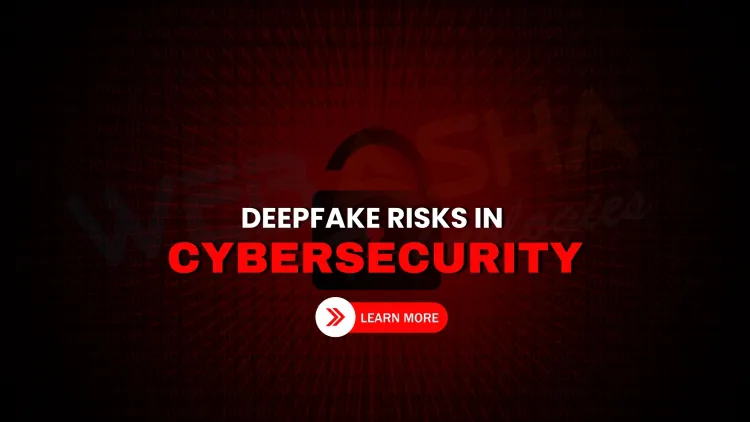What is the role of deepfakes in cyber threats, and how can individuals and organizations detect and protect against them?
Deepfakes and synthetic media are rapidly becoming a significant threat in cybersecurity. Cybercriminals use AI-generated videos, images, and voice recordings to conduct phishing scams, social engineering attacks, and espionage. These realistic but fake media files can trick even trained professionals, making them highly effective. Detection methods include using AI-based detection tools, blockchain for content verification, and digital watermarking. Organizations should also train employees to spot signs of manipulation and verify sources before trusting multimedia content.

Table of Contents
- What Are Deepfakes and Synthetic Media?
- Why Are Deepfakes a Growing Cybersecurity Threat?
- Real-World Examples of Deepfake Threats
- How Hackers Create Deepfakes
- AI in Detecting Deepfakes: What’s Being Done?
- Common Deepfake Detection Tools
- How to Protect Yourself from Deepfake Attacks
- The Future: How Deepfakes Will Shape Cybersecurity
- Conclusion
- Frequently Asked Questions (FAQs)
What Are Deepfakes and Synthetic Media?
Deepfakes are realistic digital manipulations created using artificial intelligence, typically involving videos, audio, or images. These synthetic media are made to convincingly replicate a person’s voice or face, often used to impersonate someone in a believable way.
While the technology behind deepfakes—such as generative adversarial networks (GANs)—was initially developed for harmless creative projects, it is now being weaponized by cybercriminals, hackers, and state-sponsored attackers for various malicious activities.
Why Are Deepfakes a Growing Cybersecurity Threat?
The rise of deepfakes marks a new chapter in digital deception. Unlike traditional phishing emails or scam calls, deepfakes offer a highly convincing layer of false reality. This makes them harder to detect and more likely to succeed.
Key reasons they pose a danger:
-
They’re convincing: A well-made deepfake can make it seem like a trusted person is speaking or appearing live.
-
Easy to create: Tools like DeepFaceLab or open-source AI models make creating deepfakes easier and faster.
-
Difficult to detect: Some deepfakes bypass human and machine detection methods.
Real-World Examples of Deepfake Threats
1. Phishing and Business Email Compromise (BEC)
In 2023, a deepfake audio was used to imitate a CEO’s voice, convincing a finance employee to transfer $250,000. These attacks are now called "vishing" (voice phishing) and are becoming more common.
2. Social Engineering
Attackers use deepfake videos in online meetings or chats to pose as employees or executives. It adds a layer of trust that normal social engineering emails lack.
3. Political Manipulation
Governments and cyber-espionage groups use synthetic media to create fake news, impersonate leaders, or manipulate public opinion during elections.
4. Impersonation Scams
Cybercriminals impersonate celebrities, officials, or influencers to promote fake giveaways or investment schemes.
How Hackers Create Deepfakes
Deepfake creation involves:
-
Data collection: Gather voice recordings, images, or video footage of the target.
-
Training models: Use deep learning tools like GANs or voice cloning software.
-
Post-processing: Enhance the fake media to look natural and avoid detection.
AI in Detecting Deepfakes: What’s Being Done?
Cybersecurity firms and researchers are racing to develop AI tools that detect synthetic media. Techniques include:
-
Video forensics: Detect inconsistencies in lighting, facial movements, and blinking.
-
Audio analysis: Use waveform abnormalities and background noise detection.
-
Blockchain verification: Validate original video sources using digital signatures.
Companies like Microsoft have launched tools like “Video Authenticator,” while others like Intel and Adobe are working on "Content Authenticity Initiatives" to help verify media authenticity.
Common Deepfake Detection Tools
| Tool Name | Purpose | Use Case | AI-Based |
|---|---|---|---|
| Deepware Scanner | Detect deepfake video content | Social media, news | Yes |
| Sensity AI | Enterprise-grade detection | Financial sector, government | Yes |
| Microsoft Video Authenticator | Real-time analysis | Journalists, organizations | Yes |
| Truepic | Image and video authenticity | Photo verification | No |
| Hive.ai | Content moderation & detection | Social platforms | Yes |
How to Protect Yourself from Deepfake Attacks
For Individuals:
-
Verify video sources before acting on any unusual requests.
-
Cross-check identities using phone calls or alternate communication.
-
Be skeptical of unexpected requests for money, credentials, or private data.
For Organizations:
-
Train employees to recognize social engineering and deepfakes.
-
Use AI-powered email and voice security filters.
-
Implement multi-layer verification for financial transactions or sensitive access.
The Future: How Deepfakes Will Shape Cybersecurity
As deepfake technology evolves, it will likely be used in more advanced forms of social engineering and misinformation campaigns. But defense is catching up. AI-based detection, cryptographic verification, and digital watermarking are showing promise.
Cybersecurity experts predict a future where:
-
Every video or voice communication will require digital authenticity checks.
-
Law enforcement and governments will criminalize misuse of deepfakes more aggressively.
-
Security software will include real-time deepfake scanning tools as standard.
Conclusion
Deepfakes and synthetic media are no longer just a tech curiosity—they're a serious cyber threat. From impersonation and scams to misinformation and espionage, attackers are already leveraging this technology to deceive individuals and businesses. While AI is being used to detect deepfakes, awareness, education, and verification remain key to staying safe.
As deepfakes become more common, the line between real and fake content will continue to blur. In this new digital age, trust must be verified—especially when it's just a voice or face on a screen.
FAQs
What is a deepfake in cybersecurity?
A deepfake in cybersecurity is an AI-generated video, audio, or image used to impersonate someone to gain unauthorized access or manipulate information.
How are deepfakes used in phishing scams?
Cybercriminals use deepfakes to mimic voices or faces of trusted individuals to trick victims into giving up sensitive information.
What are synthetic media threats?
Synthetic media threats involve AI-generated content used for deception, including deepfakes, fake voice recordings, and forged texts.
Are deepfakes used in espionage?
Yes, advanced attackers use deepfakes in espionage to impersonate executives or government officials and extract confidential data.
How can I detect a deepfake video?
Look for unnatural facial movements, inconsistent lighting, and audio mismatches. Use AI-based detection tools for higher accuracy.
Which tools detect deepfakes?
Tools like Microsoft's Video Authenticator, Deepware Scanner, and Intel’s FakeCatcher help detect deepfakes.
Can deepfakes bypass two-factor authentication?
In rare cases, if voice or face verification is used, deepfakes may bypass weak 2FA systems without proper liveness detection.
Are there any real cases of deepfake scams?
Yes, cases have been reported where attackers used AI-generated voices of CEOs to request fraudulent fund transfers.
How can organizations prevent deepfake threats?
Organizations should use AI detection tools, implement strong verification protocols, and train employees to recognize manipulated content.
Can deepfakes be detected by the human eye?
Sometimes, but high-quality deepfakes are often too realistic to spot without technical tools.
What industries are most at risk from deepfakes?
Finance, government, defense, and media industries are particularly vulnerable to synthetic media-based cyberattacks.
Is synthetic media always harmful?
Not necessarily. Synthetic media can be used for good purposes like film production, education, and accessibility when used ethically.
How do AI models create deepfakes?
AI models like GANs (Generative Adversarial Networks) learn from large datasets to mimic voices, faces, or gestures.
Can social media platforms stop deepfakes?
Many platforms are working on detection and labeling policies, but complete prevention is still a challenge.
What role does blockchain play in deepfake detection?
Blockchain can be used to verify the origin of media content, helping detect and flag altered or fake files.
Are there government regulations for deepfakes?
Some countries are introducing laws to criminalize malicious use of deepfakes, especially in political and financial contexts.
Can deepfakes manipulate financial markets?
Yes, fake news or video messages from influential figures can manipulate stock prices or cause market panic.
How can individuals protect themselves from deepfakes?
Verify sources, stay informed about the technology, and be skeptical of unexpected video/audio messages.
What is liveness detection?
It is a biometric technique used to ensure that the user is real and present—not a photo or deepfake.
Are there browser plugins to spot deepfakes?
Some experimental tools exist, but they are still in development and not foolproof.
Do deepfakes affect national security?
Yes, they can be used in misinformation campaigns, identity theft, and fake diplomatic messages.
How fast is deepfake technology evolving?
Extremely fast. Open-source tools make it accessible, while quality is improving rapidly with each advancement.
Can antivirus software detect deepfakes?
Traditional antivirus software doesn’t detect deepfakes; specialized AI tools are required.
How are deepfakes created from voice recordings?
Voice cloning tools use samples of a person’s voice to synthesize speech, often indistinguishable from the real person.
Is it legal to create a deepfake?
Creating deepfakes is not always illegal, but using them to deceive, defraud, or harass is often punishable.
How do deepfakes threaten elections?
They can be used to spread fake political messages or impersonate candidates, leading to misinformation and confusion.
Can deepfakes be used in blackmail?
Yes, attackers may create fake compromising content and use it to blackmail individuals.
What is the future of deepfake detection?
The future involves AI-based real-time detection, blockchain authentication, and global regulation.
How do companies like Deeptrace and Sensity AI help?
They provide tools and services to detect and monitor synthetic media threats across platforms.
How can I test if a video is fake?
You can upload the video to deepfake detection tools or check for inconsistencies manually.
Are AI-generated texts also considered synthetic media?
Yes, any content generated by AI—video, image, voice, or text—falls under synthetic media.














![Top 10 Ethical Hackers in the World [2025]](https://www.webasha.com/blog/uploads/images/202408/image_100x75_66c2f983c207b.webp)








